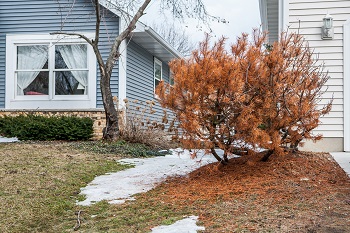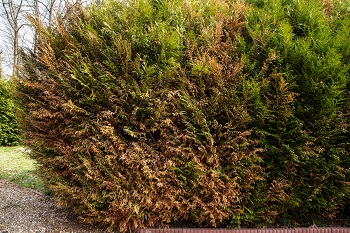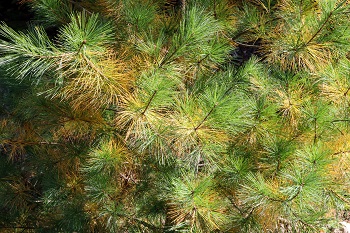
one
two
three



Winter burn is caused when an evergreen tree or shrub loses more water than it can take in. The damage ranges from brown, dry needle tips and leaf edges to the reddening of entire needles and leaves. In a bad case, entire branches can turn brown and die. Some trees, such as the one above, die entirely. Worse, the symptoms usually do not show until spring growth begins. Understanding the problem can help you prevent it.
Evergreens Never Go Totally Dormant
Even in the dead of winter, the stomates, or pores of the evergreen tree or shrub let some water out of the needle or leaf. This water has to be replaced with water the roots draw up into the tree. When the roots cannot draw up as much moisture as the tree lets out, winter burn occurs. There are several reasons why a tree or shrub cannot draw up as much water as it loses.
Drought During the Year
Roots cannot draw up water is the soil is too dry. If, at any point in the year, there has been dry weather, the tree enters the winter with drought stress. In fact, a tree or shrub that has suffered drought stress will always do worse in the winter than one who has been kept moist.
Frozen Soil, Frozen Roots
Evergreen trees and shrubs older than 2 years old should have roots that go deep in the soil. If the soil freezes deeper than the roots go, it cuts the roots off from soil moisture. It does not matter how moist the soil is, if it is frozen the roots cannot access that soil moisture. Evergreens younger than two years old do not have deep roots, so even a shallow soil freeze may cut them off from soil moisture.
Wind and Sun Are Not an Evergreen’s Friend
Winter burn is usually the worst on the side of the tree or shrub that faces the wind. As the wind goes over the stomates, it pulls water from them. This increases how much water the needles or leaves lose and increases the need for the roots to draw up moisture from the soil.

Direct sunlight or reflected sunlight also increases water loss. If a tree or shrub get warm enough, the stomates open wider, letting more water out. The reflected sunlight and warmth from a building’s surface, especially bricks, concrete, or light-colored metal siding, can really burn a plant. For example, ornamental juniper is prone to this type of injury.
Preventing Winter Burn Starts with Water
When there is insufficient rain to keep the soil moist, it is important to give your tree or shrub a deep watering, regardless of the season. When the tree or shrub is under two years old, it needs a lot of water all at once every week during the spring, summer, and fall. Watering a little water every few days keeps the roots shallow. Deep watering trains the roots to grow deep into the soil, where the moisture they need is naturally present.
When evergreens are older than two, they only require watering spring through fall when it has not rained enough for a month to keep the soil moist. Again, deep watering is important. Stop watering when a good rain comes along or it freezes. Even if there is not a dry spell, when the first frost is forecast, but before it arrives, water the evergreens deeply to make sure the roots are well hydrated when the soil freezes.
Sealing the Water In
There is a product available that can greatly reduce the water an evergreen loses in the winter. Wilt-Pruf® uses a substance found in pine pitch to build a molecular film on the leaves or needles of evergreens that helps stop water loss. It must be applied on a warm enough day that the spray does not freeze before it reaches the evergreen. Wilt-Pruf® requires 2-3 hours of ultraviolet light to set up, so spray it on when there is at least that much daylight left before dark. Wilt-Pruf® gradually wears away, one molecular layer at a time, so it will need to be sprayed again on an above freezing day in three to four months if winter is not over.
Watering in Winter
Since evergreens never go totally dormant, they must be watered during the winter. When the temperature is above 40F, check the soil around the evergreens. If it is dry, give the trees and shrubs a big drink. It is best to do this mid-morning to allow the water to soak in before the soil freezes again. It is very important to water the evergreens whenever the soil is dry, and it is not frozen. It is essential they get water through the end the cold temperatures. When spring growth starts, revert to the regular watering schedule.
Mulch Will Help
Mulch conserves the water applied to the soil. It then slowly releases it to the evergreen. Mulch also protects the roots from the cold. Mulch 3-4 inches deep. Spread it three to six feet in diameter around the tree or shrub. Do not let the mulch actually touch the trunk or it will cause rot.

Winter burn is frustrating because most damage is not visible until spring growth begins. The thing to remember with evergreens is to hydrate when the day is over 40F and the soil is dry. This will give them the best chance of surviving the winter without any injuries. For more information on taking care of your evergreens, ask us here at Royal Creations Architectural Landscaping.